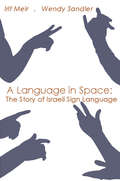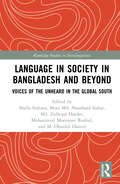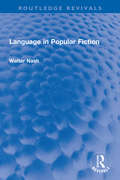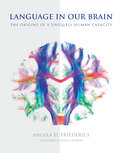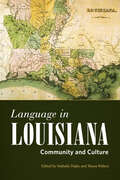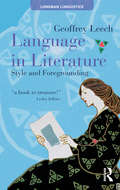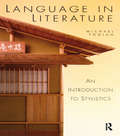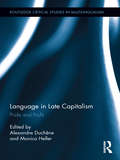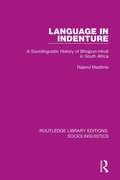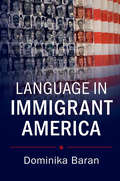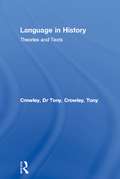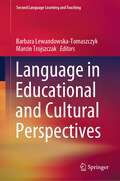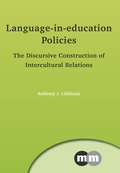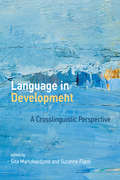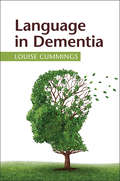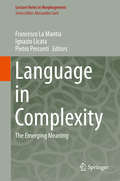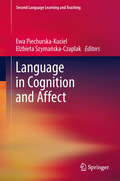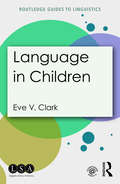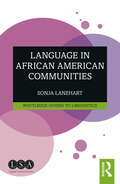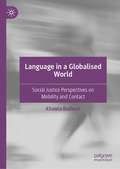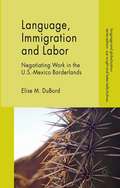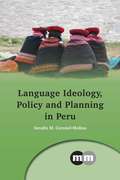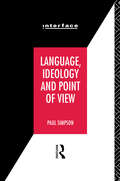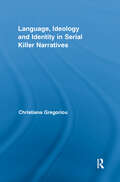- Table View
- List View
Language in the British Isles
by David BritainThe British Isles are home to a vast range of different spoken and signed languages and dialects. Language continues to evolve rapidly, in its diversity, in the number and the backgrounds of its speakers, and in the repercussions it has had for political and educational affairs. This book provides a comprehensive survey of the dominant languages and dialects used in the British Isles. Topics covered include the history of English; the relationship between Standard and Non-Standard Englishes; the major non-standard varieties spoken on the islands; and the history of multilingualism; and the educational and planning implications of linguistic diversity in the British Isles. Among the many dialects and languages surveyed by the volume are British Black English, Celtic languages, Chinese, Indian, European migrant languages, British Sign Language, and Anglo-Romani. Clear and accessible in its approach, it will be welcomed by students in sociolinguistics, English language, and dialectology, as well as anyone interested more generally in language within British society.
A Language in Space: The Story of Israeli Sign Language
by Irit Meir Wendy SandlerThis English version of A Language in Space: The Story of Israeli Sign Language, which received the Bahat Award for most outstanding book for a general audience in its Hebrew edition, is an introduction to sign language using Israeli Sign Language (ISL) as a model. Authors Irit Meir and Wendy Sandler offer a glimpse into a number of fascinatin
Language in Society in Bangladesh and Beyond: Voices of the Unheard in the Global South (Routledge Studies in Sociolinguistics)
by Shaila Sultana, Mian Md. Naushaad Kabir, Md. Zulfeqar Haider, Mohammod Moninoor Roshid, and M. Obaidul HamidThis collection presents a holistic picture of the sociolinguistic landscape in Bangladesh, offering a critical understanding of language ideologies and social inequalities in the country, as they connect more widely to dynamics in the Global South. The book seeks to untangle the voices embedded in the language practices of a range of communities and professions in the region, which have been little studied in the literature, and encourage a rethinking of the relationships between language and nationality, class, ethnicity, race, and gender. Highlighting perspectives from established and emerging researchers and drawing on a wide range of theoretical approaches and methodologies, the volume is organized around such key themes as bilingualism and diglossia; language variation across domains; language and identity in literature; and the interconnectedness of language, identity, and globalization. Taken together, the collection calls attention to the socially and spatially situated nature of language practices in Bangladesh and in turn, the ways in which scholars in the Global South make sense of the sociolinguistic landscape at both the local and global levels. This book will appeal to scholars working in sociolinguistics, particularly those working on language policy, language and identity, language variation, and in or about the Global South.
Language in Popular Fiction (Routledge Revivals)
by Walter NashFirst published in 1990, Language in Popular Fiction was written to provide a comprehensive and illuminating look at the way language is used in thrillers and romantic fiction. The book examines the use of language across three interrelated levels: a level of verbal organisation, a level of narrative structure, and a level at which stylistic options and devices are related to notions of gender. It introduces ‘the protocol of pulchritude’ and makes use of detailed stylistic and linguistic analysis to investigate a wide range of ‘popfiction’ and ‘magfiction’. In doing so, it provokes serious reflection on popular fiction and its claims on the reader.
Language in Our Brain: The Origins of a Uniquely Human Capacity (The\mit Press Ser.)
by Angela D. FriedericiA comprehensive account of the neurobiological basis of language, arguing that species-specific brain differences may be at the root of the human capacity for language.Language makes us human. It is an intrinsic part of us, although we seldom think about it. Language is also an extremely complex entity with subcomponents responsible for its phonological, syntactic, and semantic aspects. In this landmark work, Angela Friederici offers a comprehensive account of these subcomponents and how they are integrated. Tracing the neurobiological basis of language across brain regions in humans and other primate species, she argues that species-specific brain differences may be at the root of the human capacity for language.Friederici shows which brain regions support the different language processes and, more important, how these brain regions are connected structurally and functionally to make language processes that take place in milliseconds possible. She finds that one particular brain structure (a white matter dorsal tract), connecting syntax-relevant brain regions, is present only in the mature human brain and only weakly present in other primate brains. Is this the “missing link” that explains humans' capacity for language?Friederici describes the basic language functions and their brain basis; the language networks connecting different language-related brain regions; the brain basis of language acquisition during early childhood and when learning a second language, proposing a neurocognitive model of the ontogeny of language; and the evolution of language and underlying neural constraints. She finds that it is the information exchange between the relevant brain regions, supported by the white matter tract, that is the crucial factor in both language development and evolution.
Language in Louisiana: Community and Culture (America's Third Coast Series)
by Nathalie Dajko and Shana WaltonContributions by Lisa Abney, Patricia Anderson, Albert Camp, Katie Carmichael, Christina Schoux Casey, Nathalie Dajko, Jeffery U. Darensbourg, Dorian Dorado, Connie Eble, Daniel W. Hieber, David Kaufman, Geoffrey Kimball, Thomas A. Klingler, Bertney Langley, Linda Langley, Shane Lief, Tamara Lindner, Judith M. Maxwell, Rafael Orozco, Allison Truitt, Shana Walton, and Robin WhiteLouisiana is often presented as a bastion of French culture and language in an otherwise English environment. The continued presence of French in south Louisiana and the struggle against the language's demise have given the state an aura of exoticism and at the same time have strained serious focus on that language. Historically, however, the state has always boasted a multicultural, polyglot population. From the scores of indigenous languages used at the time of European contact to the importation of African and European languages during the colonial period to the modern invasion of English and the arrival of new immigrant populations, Louisiana has had and continues to enjoy a rich linguistic palate. Language in Louisiana: Community and Culture brings together for the first time work by scholars and community activists, all experts on the cutting edge of research. In sixteen chapters, the authors present the state of languages and of linguistic research on topics such as indigenous language documentation and revival; variation in, attitudes toward, and educational opportunities in Louisiana’s French varieties; current research on rural and urban dialects of English, both in south Louisiana and in the long-neglected northern parishes; and the struggles more recent immigrants face to use their heritage languages and deal with language-based regulations in public venues. This volume will be of value to both scholars and general readers interested in a comprehensive view of Louisiana’s linguistic landscape.
Language in Literature: Style and Foregrounding (Textual Explorations)
by Geoffrey LeechOver a period of over forty years, Geoffrey Leech has made notable contributions to the field of literary stylistics, using the interplay between linguistic form and literary function as a key to the 'mystery' of how a text comes to be invested with artistic potential. In this book, seven earlier papers and articles, read previously only by a restricted audience, have been brought together with four new chapters, the whole volume showing a continuity of approach across a period when all too often literary and linguistic studies have appeared to drift further apart. Leech sets the concept of 'foregrounding' (also known as defamiliarization) at the heart of the interplay between form and interpretation. Through practical and insightful examination of how poems, plays and prose works produce special meaning, he counteracts the 'flight from the text' that has characterized thinking about language and literature in the last thirty years, when the response of the reader, rather than the characteristics and meaning potential of the text itself, have been given undue prominence. The book provides an enlightening analysis of well-known (as well as less well-known) texts of great writers of the past, including Keats, Shelley, Samuel Johnson, Shaw, Dylan Thomas, and Virginia Woolf.
Language in Literature: An Introduction To Stylistics (A\hodder Arnold Publication)
by Michael ToolanAn activity-based introduction to stylistics, this textbook explains some of the topics in literary linguistics and helps students in analysing written texts. How can you tell good writing - the excellent, the brilliant and the ingenious - from bad writing - the weak, the banal and the confusing? By looking at the technique and the craft of writing, Language in Literature examines the ways in which language is organised to create particular meanings or effects. Covering a range of topics - naming patterns, modality and evaluation, the structure of simple narratives, the recording of character speech and thought, the dynamics of dialogue, presuppositions and textual revision - the book presents the structuring principles within the English language. Activities and end-of-chapter commentaries encourage a 'learning by doing' approach and equips the reader with the main linguistic terms necessary for the analysis of literary and non-literary texts.
Language in Late Capitalism: Pride and Profit (Routledge Critical Studies in Multilingualism)
by Alexandre Duchêne Monica HellerThis book examines the ways in which our ideas about language and identity which used to be framed in national and political terms as a matter of rights and citizenship are increasingly recast in economic terms as a matter of added value. It argues that this discursive shift is connected to specific characteristics of the globalized new economy in what can be thought of as "late capitalism". Through ten ethnographic case studies, it demonstrates the complex ways in which older nationalist ideologies which invest language with value as a source of pride get bound up with newer neoliberal ideologies which invest language with value as a source of profit. The complex interaction between these modes of mobilizing linguistic resources challenges some of our ideas about globalization, hinting that we are in a period of intensification of modernity, in which the limits of the nation-State are stretched, but not (yet) undone. At the same time, this book argues, this intensification also calls into question modernist ways of looking at language and identity, requiring a more serious engagement with capitalism and how it constitutes symbolic (including linguistic) as well as material markets.
Language in Indenture: A Sociolinguistic History of Bhojpuri-Hindi in South Africa (Routledge Library Editions: Sociolinguistics)
by Rajend MesthrieOriginally published in 1991. The transplantation of thousands of Indian workers to South Africa under indenture between 1860 and 1911 was a political act with far-reaching consequences for their linguistic traditions. In this book, the history of one of these Indic languages, Bhojpuri, and its adaptations to its new context are traced to the point where a distinct South African Bhojpuri koine (generally known as Hindi) came into being. The roots and subsequent evolution of this language variety, as well as the events contributing to its demise, form the basis of this study. Current patterns of usage by different generations are documented in the form of traditional folk tales, proverbs, riddles and songs, alongside personal interviews. This study offers a partial history of Bhojpuri speakers, who have been otherwise largely silent in the history of colonial Natal.
Language in Immigrant America
by Dominika BaranExploring the complex relationship between language and immigration in the United States, this timely book challenges mainstream, historically established assumptions about American citizenship and identity. Set within both a historical and a current political context, this book covers hotly debated topics such as language and ethnicity, the relationship between non-native English and American identity, perceptions and stereotypes related to foreign accents, code-switching, hybrid language forms such as Spanglish, language and the family, and the future of language in America. Work from the fields of linguistics, education policy, history, sociology, and politics are brought together to provide an accessible overview of the key issues. Through specific examples and case studies, immigrant America is presented as a diverse, multilingual, and multidimensional space in which identities are often hybridized and always multifaceted.
Language in History: Theories and Texts (The Politics of Language)
by Tony Crowley Dr Tony CrowleyIn Language in History, Tony Crowley provides the analytical tools for answering such questions. Using a radical re-reading of Saussure and Bahktin, he demonstrates, in four case studies, the ways in which language has been used to construct social and cultural identity in Britain and Ireland. For example, he examines the ways in which language was employed to construct a bourgeois public sphere in 18th Century England, and he reveals how language is still being used in contemporary Ireland to articulate national and political aspirations and why the Irish language died.By bringing together linguistic and critical theory with his own sharp historical and political consciousness, Tony Crowley provides a new agenda for language study; one which acknowledges the fact that writing about history has always been determined by the historical context, and by issues of race, class and gender. Language in History represents a major contribution to the field, and an essential text for anyone interested in language, discourse and communication.
Language in Educational and Cultural Perspectives (Second Language Learning and Teaching)
by Barbara Lewandowska-Tomaszczyk Marcin TrojszczakThis book comprises 20 chapters that have been divided into two distinct parts: language in educational contexts and language in cultural contexts. The contributions included in this book are the outcome of the conference Contacts and Contrasts that was held in Konin, Poland, in 2021 (C&C2021). The contributions featured in the first part of the part of the book focus on various issues in the field of applied linguistics, in particular language education, second and foreign language learning as well as translator training. The second part of this edited collection features chapters devoted to a range of issues at the intersection of semantics, historical and contact linguistics, as well as literature.
Language-in-education Policies
by Anthony J. LiddicoatThis book examines the ideological underpinnings of language-in-education policies that explicitly focus on adding a new language to the learners' existing repertoire. It examines policies for foreign languages, immigrant languages, indigenous languages and external language spread. Each of these contexts provides for different possible relationships between the language learner and the target language group and shows how in different polities different understandings influence how policy is designed. The book develops a theoretical account of language policies as discursive constructions of ideological positions and explicates how ideologies are developed through an examination of case studies from a range of countries. Each chapter in this book takes the form of a series of three in-depth case studies in which policies relating to a particular area of language-in-education policy are examined. Each case examines the language of policy texts from a critical perspective to deconstruct how intercultural relationships are projected.
Language in Development: A Crosslinguistic Perspective
by Edited by Gita Martohardjono and Suzanne FlynnExplorations of language development in different types of learner populations and across various languages.This volume examines language development in different types of learner populations and across various languages. The contributors analyze experimental studies of child and adult language acquisition, heritage language development, bilingualism, and language disorders. They consider theoretical and methodological issues; language development in children, discussing topics that range from gestures to errors in person and number agreement; and development and attrition of (morpho)syntactic constructions in second language learners, bilinguals, and Alzheimer's patients. The approach is "crosslinguistic" in three senses of the word: the contributors offer analyses of acquisition phenomena in different languages; they consider "crosslinguistic influence," or the potential effects of multiple languages on one another in the mind of the same speaker; and (in a novel use of the term, proposed by the editors) the chapters bring together theoretical and methodological approaches pertinent to the linguistics of language development in children, adults, and heritage speakers.
Language in Dementia
by Louise CummingsDementia is a devastating condition, with profound cognitive changes affecting every aspect of an individual's functioning. The loss of communication is one symptom above others that causes distress and impacts negatively on quality of life, yet it is still one of the least understood aspects of dementia. This book undertakes a comprehensive examination of language and communication in individuals with cognitive impairment and dementia. Each chapter covers a specific neurodegenerative disorder, and addresses the epidemiology, aetiology, pathophysiology, prognosis and clinical features, along with the assessment and treatment of these disorders by speech-language pathologists. Many examples of language from individuals with neurodegenerative conditions are included, to explain clearly the effects of dementia on communication, and there are exercises at the end of each chapter, to develop language analysis skills. The book is suitable reading for all medical and health professionals, including speech-language pathologists, clinical psychologists and neuropsychologists, geriatricians, neurologists and psychiatrists.
Language in Complexity
by Francesco La Mantia Ignazio Licata Pietro PercontiThis contributed volume explores the achievements gained and the remaining puzzling questions by applying dynamical systems theory to the linguistic inquiry. In particular, the book is divided into three parts, each one addressing one of the following topics: 1) Facing complexity in the right way: mathematics and complexity 2) Complexity and theory of language 3) From empirical observation to formal models: investigation of specific linguistic phenomena, like enunciation, deixis, or the meaning of the metaphorical phrases The application of complexity theory to describe cognitive phenomena is a recent and very promising trend in cognitive science. At the time when dynamical approaches triggered a paradigm shift in cognitive science some decade ago, the major topic of research were the challenges imposed by classical computational approaches dealing with the explanation of cognitive phenomena like consciousness, decision making and language. The target audience primarily comprises researchers and experts in the field but the book may also be beneficial for graduate and post-graduate students who want to enter the field.
Language in Cognition and Affect
by Elżbieta Szymańska-Czaplak Ewa Piechurska-KucielThe volume contains most updated theoretical and empirical research on foreign or second language processes analyzed from the perspective of cognition and affect. It consists of articles devoted to various issued related to such broad topics as gender, literacy, translation or culture, to mention a few. The collection of papers offers a constructive and inspiring insight into a fuller understanding of the interconnection of the language-cognition-affect trichotomy.
Language in Children (Routledge Guides to Linguistics)
by Eve V. ClarkLanguage in Children provides a concise and basic introduction for students studying child language acquisition for the first time. Starting from the first sounds a child produces, this book covers all the stages a child goes through in acquiring a language. This title: Illustrates developmental stages from the recognition of sounds and words to the ability to hold a conversation, also covering bilingual upbringing and language disorders; Features real-life examples of all the phenomena discussed, from languages such as French, Spanish and Portuguese as well as English; Incorporates guidance on sources for further reading and exploration by chapter; Is supported by a companion website that includes exercises with links to real-world data in the CHILDES archive. Written by an experienced author and teacher, Language in Children is essential reading for students studying this topic.
Language in African American Communities (Routledge Guides to Linguistics)
by Sonja LanehartLanguage in African American Communities is essential reading for anyone with an interest in the language, culture, and sociohistorical contexts of African American communities. It will also benefit those with a general interest in language and culture, language and language users, and language and identity. This book includes discussions of traditional and non-traditional topics regarding linguistic explorations of African American communities that include difficult conversations around race and racism. Language in African American Communities provides: • an introduction to the sociolinguistic and paralinguistic aspects of language use in African American communities; sociocultural and historical contexts and development; notions about grammar and discourse; the significance of naming and the pall of race and racism in discussions and research of language variation and change; • activities and discussion questions which invite readers to consider their own perspectives on language use in African American communities and how it manifests in their own lives and communities; and • links to relevant videos, stories, music, and digital media that represent language use in African American communities. Written in an approachable, conversational style that uses the author’s native African American (Women’s) Language, this book is aimed at college students and others with little or no prior knowledge of linguistics.
Language in a Globalised World: Social Justice Perspectives on Mobility and Contact
by Khawla BadwanThis book takes a critical look at the role of language in an increasingly diversified and globalised world, using the new framework of 'sociolinguistics of globalisation' to draw together research from human geography, sociolinguistics, and intercultural communication. It argues that globalisation has resulted in a destabilisation of social and linguistic norms, and presents a ‘language-in-motion’ approach which addresses the inequalities and new social divisions brought by the unprecedented levels of population mobility. This book looks at language on the individual, national and transnational level, and it will be of interest to readers with backgrounds in history, politics, human geography, sociolinguistics and minority languages.
Language, Immigration and Labor
by Elise M. DubordThis book explores dominant ideologies about citizenship, nation, and language that frame the everyday lives of Spanish-speaking immigrant day laborers in Arizona. It examines the value of speaking English in this context and the dynamics of intercultural communication in fast-paced job negotiations.
Language Ideology, Policy and Planning in Peru
by Serafín M. Coronel-MolinaThis book explores the role of language academies in preserving and revitalizing minority or endangered languages. The author studies the controversial High Academy of the Quechua Language (HAQL) in Peru, the efficacy of which has been questioned by some experts. The book delves into the positions, attitudes, ideologies and practices of the HAQL and the role it has played in language policy and planning in the Andean region. The author uses ethnographic fieldwork to support what was previously only anecdotal evidence from individuals viewing the Academy from the outside. This book would appeal to anyone studying the sociolinguistics of the Quechua language, as well as to those studying broader issues of Indigenous language policy and planning, maintenance and revitalization.
Language, Ideology and Point of View (Interface)
by Paul SimpsonThis systematic introduction to the concept of point of view in language explores the ways in which point of view intersects with and is shaped by ideology. It specifically focuses on the way in which speakers and writers linguistically encode their beliefs, interests and biases in a wide range of media. The book draws on an extensive array of linguistic theories and frameworks and each chapter includes a self-contained introduction to a particular topic in linguistics, allowing easy reference. The author uses examples from a variety of literary and non-literary text types such as, narrative fiction, advertisements and newspaper reports.
Language, Ideology and Identity in Serial Killer Narratives (Routledge Studies in Rhetoric and Stylistics)
by Christiana GregoriouIn this book, Gregoriou explores the portrayal of the serial killer identity and its related ideology across a range of contemporary crime narratives, including detective fiction, the true crime genre and media journalism. How exactly is the serial killer consciousness portrayed, how is the killing linguistically justified, and how distinguishing is the language revolving around criminal ideology and identity across these narrative genres? By employing linguistic and content-related methods of analysis, her study aims to work toward the development of a stylistic framework on the representation of serial killer ideology across factual (i.e. media texts), factional (i.e. true crime books) and fictional (i.e. novels) murder narratives. ‘Schema’ is a term commonly used to refer to organised bundles of knowledge in our brains, which are activated once we come across situations we have previously experienced, a ‘group schema’ being one such inventory shared by many. By analysing serial murder narratives across various genres, Gregoriou uncovers a widely shared ‘group schema’ for these murderers, and questions the extent to which real criminal minds are in fact linguistically fictionalised. Gregoriou’s study of the mental functioning and representation of criminal personas can help illuminate our schematic understanding of actual criminal minds.

